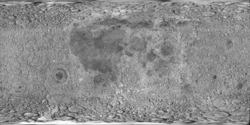Gator (cráter)
Gator es un pequeño cráter lunar perteneciente a las Tierras Altas de Descartes, visitado por los astronautas del Apolo 16. El nombre del cráter fue adoptado formalmente por la Unión Astronómica Internacional en 1973.[1] Su diámetro es un poco más pequeño que el de Palmetto (al oesnoroeste).
| Gator Cráter lunar | ||
|---|---|---|
 Imagen LRO | ||
| Coordenadas | 8°57′S 15°33′E / -8.95, 15.55 | |
| Diámetro | 850 m[1] | |
| Profundidad | 127 m | |
| Epónimo | Cráter nombrado por los astronautas (topónimo procedente del Lunar Topophotomap) | |
|
Localización sobre el mapa lunar | ||

 |
El módulo lunar Orion del Apolo 16 aterrizó entre los cráteres North Ray y South Ray el 21 de abril de 1972. Los astronautas John Young y Charles M. Duke exploraron el área entre los cráteres en el transcurso de tres EVAs utilizando un Lunar Roving Vehicle o rover. Visitaron North Ray en la EVA 3, donde situaron la Estación 11, a unos 4.4 kilómetros al norte del lugar de aterrizaje. Pasaron entre el lado este de Palmetto y Gator en su recorrido de ida y vuelta hacia North Ray, pero no se detuvieron allí.
Gator se inserta en la Formación Cayley del Período Ímbrico.[2]
Denominación
editarEl nombre del cráter fue adoptado formalmente por la UAI en 1973,[1] y tiene su origen en las denominaciones topográficas utilizadas en la hoja a escala 1/50.000 del Lunar Topophotomap con la referencia "78D2S1 Apollo 16 Landing Area".[3]
Véase también
editarReferencias
editar- ↑ a b c Gator, Gazetteer of Planetary Nomenclature, International Astronomical Union (Unión Astronómica Internacional) Working Group for Planetary System Nomenclature (WGPSN)
- ↑ Geologic Map of the Apollo 16 (Descartes) Landing Area Archivado el 21 de julio de 2019 en Wayback Machine. by Apollo Field Geology Investigation Team (D. P. Elston, E. L. Boudette, J. P. Schafer), Servicio Geológico de los Estados Unidos, April 1972
- ↑ Lunar and Planetary Institute
- (WGPSN), IAU Working Group for Planetary System Nomenclature (13 de febrero de 2013). «Gazetteer of Planetary Nomenclature. 1:1 Million-Scale Maps of the Moon» (en inglés). UAI / USGS. Consultado el 6 de abril de 2016.
- Andersson, L. E.; Whitaker, E. A., (1982). NASA Catalogue of Lunar Nomenclature (en inglés). NASA RP-1097.
- Blue, Jennifer (25 de julio de 2007). «Gazetteer of Planetary Nomenclature» (en inglés). USGS. Consultado el 2 de enero de 2012.
- Bussey, B.; Spudis, P. (2004). The Clementine Atlas of the Moon (en inglés). Nueva York: Cambridge University Press. ISBN 0-521-81528-2.
- Cocks, Elijah E.; Cocks, Josiah C. (1995). Who's Who on the Moon: A Biographical Dictionary of Lunar Nomenclature (en inglés). Tudor Publishers. ISBN 0-936389-27-3.
- McDowell, Jonathan (15 de julio de 2007). «Lunar Nomenclature» (en inglés). Jonathan's Space Report. Consultado el 2 de enero de 2012.
- Menzel, D. H.; Minnaert, M.; Levin, B.; Dollfus, A.; Bell, B. (1971). «Report on Lunar Nomenclature by The Working Group of Commission 17 of the IAU». Space Science Reviews (en inglés) 12: 136.
- Moore, Patrick (2001). On the Moon (en inglés). Sterling Publishing Co. ISBN 0-304-35469-4.
- Price, Fred W. (1988). The Moon Observer's Handbook (en inglés). Cambridge University Press. ISBN 0521335000.
- Rükl, Antonín (1990). Atlas of the Moon (en inglés). Kalmbach Books. ISBN 0-913135-17-8.
- Webb, Rev. T. W. (1962). Celestial Objects for Common Telescopes, 6ª edición revisada (en inglés). Dover. ISBN 0-486-20917-2.
- Whitaker, Ewen A. (2003). Mapping and Naming the Moon (en inglés). Cambridge University Press. 978-0-521-54414-6.
- Wlasuk, Peter T. (2000). Observing the Moon (en inglés). Springer. ISBN 1-85233-193-3.
- «Lunar Impact Crater Database» (en inglés). Lunar and Planetary Institute (USRA). Consultado el 12 de septiembre de 2017.
Enlaces externos
editar- Referencia UAI del CRÁTER
- Apollo 16 Traverses, 78D2S2 (25), Lunar and Planetary Institute
- LPI Digital Lunar Orbiter Photographic Atlas of the Moon
- Mapa LROC
- The-moon.wikispaces.com: Gator Archivado el 30 de mayo de 2018 en Wayback Machine.
- Wikimedia Commons alberga una categoría multimedia sobre Gator.
